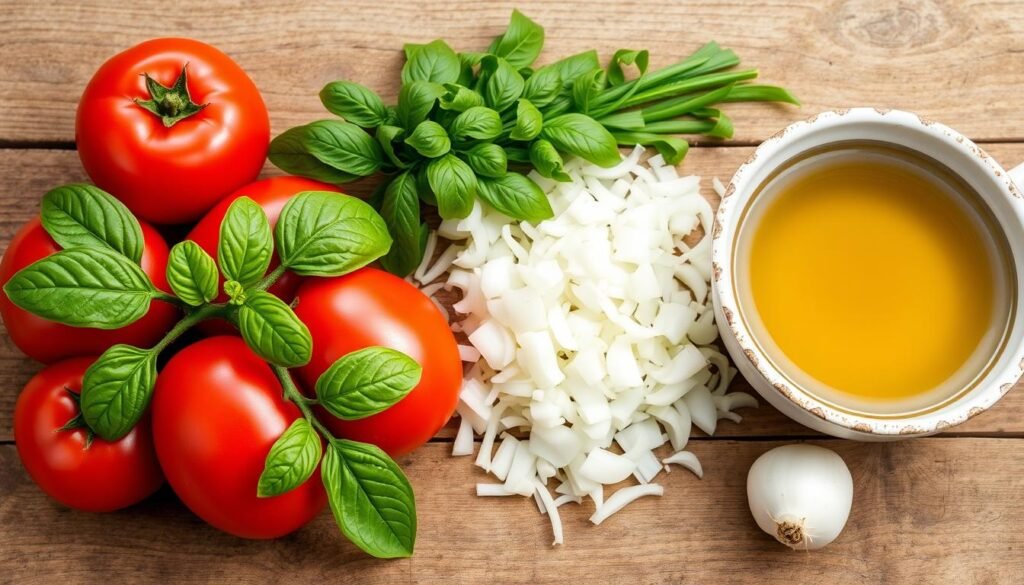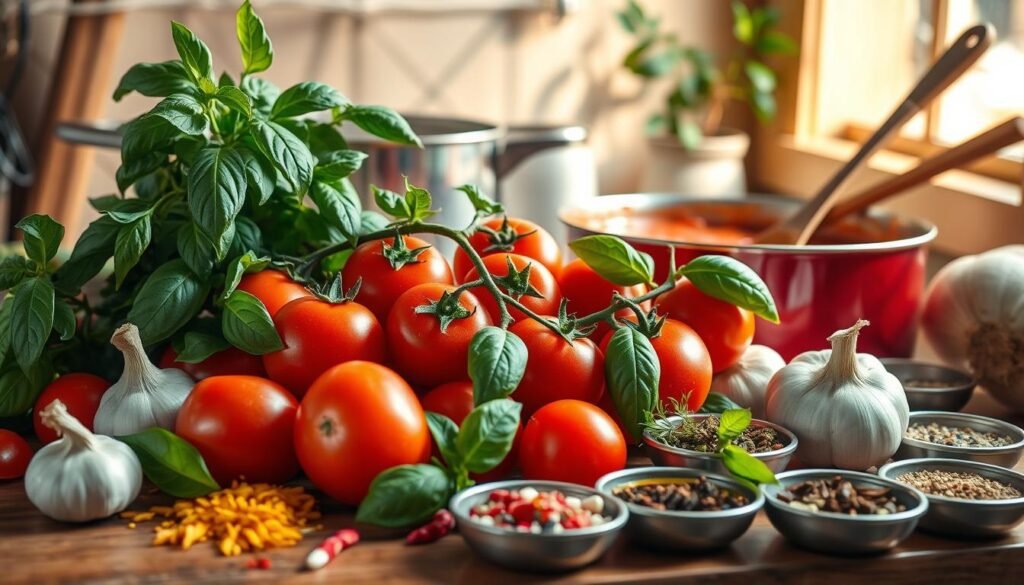Welcome to the delightful world of Low-Fat Tomato Basil Soup, a healthy soup recipe that brings together the freshness of ripe tomatoes and fragrant basil. This comforting dish is not only low in fat but also incredibly easy to prepare, making it a must-try for anyone looking to enjoy a nourishing meal. Whether you’re winding down after a long day or hosting friends, this tomato soup serves as a perfect companion, bursting with flavor and wholesome goodness. Get ready to dive deeper into its health benefits, essential ingredients, and step-by-step cooking guide!
Introduction to Low-Fat Tomato Basil Soup
The introduction to tomato basil soup reveals a delightful option for those seeking a nutritious meal. This comforting dish not only warms the soul but also keeps calorie intake in check, making it a great choice for health-conscious individuals. With its blend of fresh tomatoes and fragrant basil, it becomes a healthy tomato soup that is both flavorful and satisfying.
Whether enjoyed for a casual lunch or served at a more elegant dinner, low-fat tomato basil soup offers versatility that caters to various tastes. The beauty of this quick soup recipe lies in its simplicity, allowing for easy preparation without compromising on taste or nutrition. Indulge in this recipe as you savor the rich flavors and vibrant colors that make it a standout in any meal.
Health Benefits of Tomato Basil Soup
Tomato basil soup is a delicious and nutritious choice, rich in beneficial compounds that can elevate health. The primary ingredients, tomatoes and basil, are not just flavorful but also packed with significant health perks. Understanding their nutritional contributions helps in appreciating this delightful nutritional soup.
Nutritional Value of Tomatoes
Tomatoes serve as a cornerstone of this soup, delivering a wide array of nutrients. Their rich content of vitamins C and K, potassium, and antioxidants like lycopene presents numerous health benefits of tomatoes. Lycopene, in particular, is noted for its role in combating free radicals, potentially reducing the risk of chronic diseases. Here’s a quick breakdown of the nutritional value of tomatoes:
| Nutrient | Amount per 100g |
|---|---|
| Calories | 18 |
| Vitamin C | 13.7 mg |
| Vitamin K | 7.9 mcg |
| Potassium | 237 mg |
| Lycopene | 2573 mcg |
Benefits of Fresh Basil
Fresh basil adds not only a fragrant flavor to the soup but also numerous basil health benefits. This aromatic herb boasts anti-inflammatory properties, which can be advantageous for those looking to support their immune system. Furthermore, basil may aid digestion and promote overall gut health, making it an essential ingredient in this comforting dish. The following highlights some of its valuable components:
- Rich in antioxidants
- Contains essential oils that may reduce stress
- Potential antibacterial properties
- Helps to alleviate gastrointestinal discomfort
Key Ingredients in Low-Fat Tomato Basil Soup
Creating a delicious low-fat tomato basil soup relies heavily on selecting the right ingredients. The key ingredients tomato basil soup, particularly the tomatoes and basil, significantly influence the overall flavor profile. Understanding how to choose fresh tomatoes and the various basil types can elevate this classic dish to new heights.
Choosing the Right Tomatoes
For the best flavor in your low-fat tomato basil soup, opting for ripe and juicy fresh tomatoes is essential. Varieties such as Roma or vine-ripened tomatoes pack the most juiciness and sweetness. These tomatoes provide a robust base while ensuring that you enjoy a creamy texture without adding any fat. When selecting tomatoes, look for:
- Brightly colored, firm skins
- Flesh that yields slightly when pressed
- A sweet, fragrant aroma
Using fresh tomatoes not only enhances taste but also boosts the nutritional value of your soup.
Fresh vs. Dried Basil: What to Use?
Basil is a crucial ingredient that adds aromatic freshness to tomato basil soup. While both fresh and dried basil can be used, they each contribute differently to the dish.
Fresh basil provides a vibrant flavor and pronounced aroma. Adding it towards the end of the cooking process ensures its flavor remains intact. On the other hand, dried basil, though more concentrated, lacks the fresh notes that complement the soup so well. Here’s a quick comparison:
| Basil Type | Flavor | Usage |
|---|---|---|
| Fresh Basil | Bright, aromatic, lively | Added at the end of cooking |
| Dried Basil | Earthy, concentrated | Best used at the beginning of cooking |
Ultimately, for the most delightful results, pairing fresh tomatoes with fresh basil will yield the best outcome in creating a memorable low-fat tomato basil soup.

Step-by-Step Recipe for Low-Fat Tomato Basil Soup
This easy tomato basil soup recipe is perfect for a quick and healthy meal. With a preparation time of approximately 10 minutes and yielding about four servings, it’s an ideal option for a busy weeknight dinner or a comforting lunch. Follow these detailed cooking instructions for a delicious and nutritious soup.
Preparation Time and Serving Size
- Preparation Time: 10 minutes
- Serving Size: 4 servings
Detailed Cooking Instructions
- Start by dicing one medium onion and mincing two cloves of garlic.
- In a large pot, heat one tablespoon of olive oil over medium heat.
- Add the diced onion and minced garlic, sautéing until the onion becomes translucent, about 3-4 minutes.
- Next, pour in four cups of vegetable broth along with two cans of chopped tomatoes (about 14.5 ounces each). Stir to combine.
- Add one cup of fresh basil leaves, rinsed and torn for enhanced flavor.
- Season with salt and pepper to taste.
- Bring the mixture to a simmer and let it cook for 10 minutes.
- Using an immersion blender, puree the soup until smooth. If using a traditional blender, allow the soup to cool slightly, then blend in batches.
- For added richness, you can stir in a tablespoon of balsamic vinegar just before serving.
This healthy soup preparation offers a vibrant and satisfying dish that warms the soul. Enjoy this low-fat tomato basil soup as a standalone meal or paired with your favorite bread for a heartier option.
Low-Fat Tomato Basil Soup Macronutrient Breakdown
Understanding the nutritional information of low-fat tomato basil soup enhances appreciation for this delicious dish. With a balance of flavors and nutrients, it’s no wonder it fits into many diets as a satisfying option. The analysis includes caloric content and essential soup macronutrients that make up each serving profile.
Caloric Content per Serving
Each serving of low-fat tomato basil soup contains approximately 150 calories. This makes it an excellent choice for those seeking healthy soup servings without compromising taste. The soup offers a light yet fulfilling experience, perfect for a hearty lunch or a warm side dish at dinner.
Protein, Fat, and Carbohydrate Ratios
This soup achieves a nutritious profile through a favorable balance of macronutrients. Below is a breakdown of the key components:
| Macronutrient | Amount per Serving |
|---|---|
| Calories | 150 |
| Protein | 6g |
| Fat | 3g |
| Carbohydrates | 28g |
| Fiber | 5g |
This breakdown showcases how the recipe emphasizes lower fat and carbohydrate levels while maintaining a decent protein count. Overall, the nutritional profile supports a balanced diet and aligns with health-conscious goals.
Tips for Making the Best Low-Fat Tomato Basil Soup
Creating the perfect low-fat tomato basil soup involves not just the right ingredients but also clever techniques to enhance flavor. These helpful tips for tomato soup ensure that the dish remains vibrant and full of taste without adding extra fat. Consider incorporating variations to keep the soup exciting and adaptable to different palates.
Enhancing Flavor Without Extra Fat
To elevate the taste of your tomato basil soup without relying on additional fats, explore these strategies:
- Use vegetable broth as a base for added depth.
- Add herbs such as thyme or oregano for an aromatic touch.
- Incorporate spices like smoked paprika or red pepper flakes for a kick.
- Finish with a squeeze of fresh lemon juice or a splash of balsamic vinegar.
- Blend in sun-dried tomatoes for a concentrated tomato flavor.
Variations to Consider
Experimenting with different ingredients leads to exciting soup variations. Adapt the recipe by trying the following:
- Add diced carrots and celery for an earthy crunch.
- Include lentils or quinoa for added protein and texture.
- Replace tomatoes with roasted red peppers for a sweeter profile.
- Incorporate greens like spinach or kale for a nutritional boost.
- Experiment with different types of stocks, such as chicken or mushroom, to find your preferred flavor.

Implementing these tips for tomato soup not only boosts flavor but also ensures a wholesome meal that can vary with every preparation.
Perfect Pairings for Tomato Basil Soup
Pairing your low-fat tomato basil soup with the right accompaniments can elevate your meal to new heights. The best pairings for tomato soup consist of options that add complementary flavors and textures. Selecting the ideal side dishes for soup and bread can enhance the dining experience, transforming a simple bowl of soup into a memorable meal.
Recommended Side Dishes
When considering side dishes that pair wonderfully with tomato basil soup, choices abound. Here are a few suggestions that work particularly well:
- Grilled Cheese Sandwich – A classic combination that adds a crunchy, cheesy texture.
- Mixed Green Salad – A light and refreshing option that balances the richness of the soup.
- Roasted Vegetables – Seasonal veggies that enhance flavor and add nutritional value.
- Bruschetta – Fresh toppings on toasted bread provide a burst of flavor.
Best Breads to Serve Alongside
When it comes to choosing the right bread options for tomato basil soup, several types can complement the soup beautifully. Consider these delightful selections:
- Crusty Baguette – Perfect for dipping and adds a satisfying crunch.
- Warm Focaccia – Soft and flavorful, it’s ideal for soaking up the delicious broth.
- Sourdough Bread – Offers a tangy flavor that pairs nicely with the soup’s sweetness.
- Garlic Bread – A bold choice that enhances the overall taste experience.
| Side Dish | Flavor Profile | Texture |
|---|---|---|
| Grilled Cheese Sandwich | Cheesy, savory | Crispy outside, gooey inside |
| Mixed Green Salad | Fresh, light | Crisp |
| Roasted Vegetables | Earthy, sweet | Tender |
| Bruschetta | Fresh, herby | Crunchy |
| Crusty Baguette | Buttery, rich | Crunchy |
| Warm Focaccia | Herbaceous, savory | Soft |
| Sourdough Bread | Tangy | Crisp crust, chewy |
| Garlic Bread | Garlicky, buttery | Crispy top, soft center |
Storage and Meal Prep Tips
Proper storage can significantly extend the life of your Low-Fat Tomato Basil Soup while maintaining its great flavor. For soup storage tips, make sure to use airtight containers to keep your meal prep soup fresh in the fridge. Leftover soup can safely stay in the fridge for up to 3 days. Always allow the soup to cool down before transferring it to the fridge to prevent condensation.
For longer storage, consider freezing the soup. It can last in freezer storage for up to 3 months without sacrificing its goodness. Portion out the soup in convenient servings using freezer-safe containers. This allows for easy access during busy days when you want a quick meal.
Here’s a handy table that outlines the optimal methods of storage:
| Storage Method | Duration | Tips |
|---|---|---|
| Fridge Storage | Up to 3 days | Use airtight containers; cool before refrigerating. |
| Freezer Storage | Up to 3 months | Portion out servings; label with date. |
Incorporating these soup storage tips will not only save time but also help to mitigate food waste. Meal prep soup is an excellent way to enjoy healthy meals throughout the week, simplifying mealtime without compromising taste.
Serving Suggestions for Low-Fat Tomato Basil Soup
Elevating the experience of serving tomato basil soup can transform a simple meal into a delightful culinary moment. Thoughtful presentation can enhance the flavor and visual appeal, making your dish more inviting. Here are some creative garnish ideas and presentation tips to make your dish stand out.
Garnishing Ideas for Visual Appeal
A well-garnished bowl of soup not only looks appetizing but also adds layers of flavor. Consider these garnish ideas for your low-fat tomato basil soup:
- Fresh basil leaves: A few whole leaves or a small sprig on top bring a bright, aromatic freshness.
- Balsamic glaze: A drizzle adds a rich sweetness and a sophisticated aesthetic.
- Parmesan cheese: Shavings or a sprinkle provide a savory contrast, enhancing the overall taste.
- Croutons: Crispy bread pieces introduce a delightful crunch for texture variation.
- Olive oil drizzle: A simple touch of quality oil can elevate both flavor and appearance.
These garnish ideas not only beautify your dish but also contribute unique flavors, enhancing the enjoyment of serving tomato basil soup.
Incorporating these presentation tips can help create an inviting atmosphere. Use vibrant bowls that complement the soup’s color, and serve alongside crusty bread on a decorative cutting board for a rustic touch. Arranging garnishes artfully will impress your guests, ensuring that the experience is memorable.
Adapting the Recipe for Dietary Needs
Creating a versatile low-fat tomato basil soup allows for various dietary adaptations. This dish can be easily tailored to fit gluten-free options and accommodate those looking for a low-carb soup.
For a gluten-free version, use certified gluten-free broth. Many store-bought broths contain gluten, so checking labels is essential. Instead of traditional thickening agents like flour, consider options such as cornstarch or blended vegetables. These substitutions maintain the soup’s velvety texture without compromising taste.
When it comes to low-carb soup adaptations, substituting high-carb ingredients for lower-carb alternatives can make a significant difference. For example, reducing the quantity of carrots or removing any starchy vegetables will lower overall carbohydrate content. Instead, add more tomatoes and seasoning to enhance the flavor profile.
Here’s a quick overview of some effective substitutions:
| Ingredient | Gluten-Free Substitute | Low-Carb Substitute |
|---|---|---|
| Broth | Certified gluten-free broth | Low-sodium vegetable or chicken broth |
| Thickener | Cornstarch | Puréed cauliflower or zucchini |
| Carrots | Reduce quantity or use diced peppers | Eliminate or use substituted non-starchy vegetables |
These dietary adaptations ensure your tomato soup remains delicious while catering to different nutritional needs, allowing everyone to enjoy this comforting dish. With a few adjustments and creativity in the kitchen, you can serve a satisfying meal that meets gluten-free and low-carb expectations.
Exploring Alternative Ingredients
For those looking to make a delicious low-fat tomato basil soup while adhering to a vegan diet, there are several viable alternative ingredients. By incorporating vegan substitutions, you can maintain the richness and flavor profile that makes this soup so delightful. Whether it’s a creamy texture you desire or just a little extra depth, the right alternatives can work wonders.
Vegan Alternatives to Dairy Ingredients
When it comes to creating a dairy-free soup, there are several excellent options to consider. You might use coconut milk or almond milk, which provide a lovely creaminess without the dairy. For a cheesier flavor without the calories, nutritional yeast can be a fantastic addition. Furthermore, there are various cashew-based creams which can elevate your dish while keeping it within the realm of alternative ingredients for tomato basil soup.
In addition to these vegan substitutions, consider adding ingredients like silken tofu, which can blend smoothly for a rich consistency. This way, you ensure that your soup remains comforting and enjoyable for all, regardless of dietary preferences. Such thoughtful ingredient choices not only make the soup accessible but also broaden its appeal, proving that a nourishing vegan version of this classic dish is entirely achievable.

